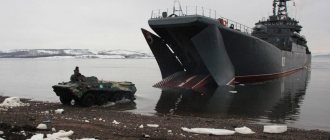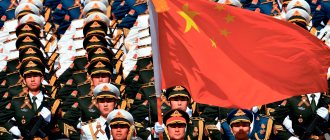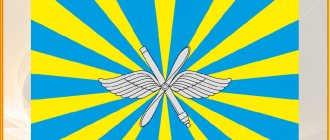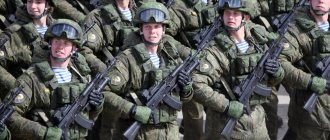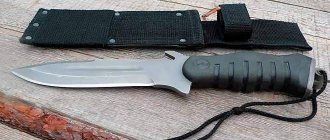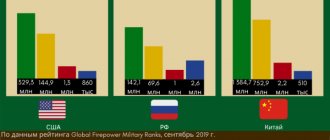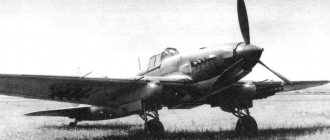US Marine Corps - history, structure, weapons
The US Marine Corps (English United States Marine Corps, USMC, US Marines) is a highly mobile branch of the military, designed for amphibious operations and combat operations in the coastal zone in cooperation with the fleet, ground forces and air force as in an all-out war, and in local wars using conventional and nuclear weapons.
The Marine Corps , an important component of the country's armed forces, is kept in constant combat readiness and is used by the American military-political leadership as a strike force.
Marines perform police and guard duties on ships and naval bases. In addition, modern concepts of warfare provide for the participation of marine units in a “small war”, their conduct of independent raids in desert and jungle conditions, the destruction of illegal armed groups, the evacuation of civilians from war-torn regions, etc.
The Marine Corps is subordinate to the US Department of the Navy. According to existing US laws, of all branches of the military, only the Marine Corps can be used by the President to perform any task without the authorization of Congress.
A typical example of such use can be considered the events of 1992 in Los Angeles, when marines were quickly brought into the city to suppress riots.
History of the United States Marine Corps
The US Marine Corps traces its history back to 1775. During the Revolutionary War, the Second Continental Congress approved the creation of two battalions of Marines to serve on ships of the Continental Fleet.
In 1798, the Fifth United States Congress formally established the United States Marine Corps. Throughout their 235-year history, the Marines have distinguished themselves for their nation in many battles, from the Battle of Belleau Wood to Iwo Jima, from the Battle of Chosin Reservoir to the Siege of Khe Sanh and the Assault on Fallujah. Because Marine Corps units are traditionally trained, organized, and equipped specifically for operations outside of their own territory, the Marine Corps has long been considered America's first response force.
US Marine Corps Command
General James Conway is the 34th Commander of the United States Marine Corps . Conway is an experienced infantry officer, having previously led the 1st and 2nd Marine Divisions and served in Operations Desert Storm and Operation Iraqi Freedom, with two deployments to Iraq.
The Commander is the highest ranking officer in the Marine Corps. Along with the commander of the Navy, he is a member of the Joint Committee of Staff. The MP commander is responsible for the planning, employment and supply of units and subunits of the Corps and garrison commands.
Organization and administration of the United States Marine Corps
Marine Forces Atlantic and Marine Corps Command (MARFORCOM)
The headquarters of the United States Marine Corps (MARFORCOM) is located at Naval Station Norfolk. The Atlantic Forces, which along with the Pacific Forces and the Corps Reserve are the largest Marine Corps formations, is led by Lt. Gen. Richard F. Natonski. He also commands Marine Corps Atlantic Fleet and all of the Corps' Atlantic bases that support Marine and other U.S. commands in NATO operations. MARFORCOM has approximately 45,000 II Marine Expeditionary Force personnel, led by Lt. Gen. Dennis J. Hejlik, headquartered at Camp Lejeune, NC. Part of the 2nd Marine Division, led by Maj. Gen. Richard T. Tryon, is performing missions in Afghanistan.
Marine Corps Forces Pacific (MARFORPAC)
Pacific Forces Headquarters, under the command of Lt. Gen. Keith J. Stalder, is located at Camp Smith, Hawaii; The force is part of US Central Command and has approximately 84,000 Marines and sailors. MARFORPAC includes the I Marine Expeditionary Force (MEF), led by Lt. Gen. Joseph F. Dunford Jr.. I MEF headquarters is located at Camp Pendleton, California. Units of the 1st Marine Division, commanded by Maj. Gen. Richard P. Mills, operate in Iraq's Al Anbar province and Afghanistan. III MEF, commanded by Lt. Gen. Terry G. Robling, is headquartered in Okinawa, Japan. Parts of the 3rd Marine Division, led by Brig. Gen. James B. Laster, operate in Afghanistan.
US Marine Corps Reserve (MARFORRES); forces "North"
The Corps Reserve , under the leadership of Lt. Gen. John F. Kelly, headquartered in New Orleans, numbers approximately 39,600 Marines and sailors, including the 4th Marine Division, led by Maj. Gen. James Williams (Maj. Gen. James L. Williams), 4th Marine Aircraft Wing and 4th Maintenance Group. The reserve is intended to build up and restore the capabilities of existing Marine Corps formations, including those performing numerous overseas raids for combat and other purposes. The reserve also represents the main force at the disposal of the US North American Command.
Combat Development Directorate (MCCDC)
the Marine Corps Base at Quantico (Quantico, Va.) is headed by Lt. Gen. George J. Flynn. The directorate is the center for operational analysis and development of Marine combat capabilities and theories of employment. The directorate includes the Warfare Laboratory, headed by Brig. Gen. Robert F. Hedelund, who is also the Deputy Chief of Naval Research. The laboratory's role is to develop new ideas and technologies, as well as to "play out" future combat concepts. Another branch of the department is the Center for Irregular Warfare (CIW), which develops Marine Corps doctrine and tactics for contingency operations in humanitarian, peacekeeping, security, and other missions. The Center also examines sea-based conditions, concepts from other navies, and operational experiences that may be relevant to Corps theory and practice.
Corps Weapons Directorate (MARCORSYSCOM)
The control headquarters is located in Quantico. The directorate's chief, Brig. Gen. Michael M. Brogan, is responsible for the execution and management of weapons programs. In response to the Navy's growing capabilities, these programs include the acquisition and development of specific weapons systems designed for Marine Corps operations, including command and control systems, infantry weapons and equipment, armored personnel carriers, and artillery. The command's activities enable Marines to better counter a variety of threats; for example, together with the army and navy, the department is participating in the development of a mine-protected all-terrain vehicle, the delivery of which to the troops will help avoid losses from explosions.
Special Operations Command (MARSOC)
The headquarters of the Special Operations Command, under the command of Maj. Gen. Paul E. Lefebvre, is located at the Marine Corps Camp Lejeune. The command has 2,600 Marines and sailors trained to perform special operations. The command consists of two battalions located at Camp LeJeune and Camp Pendleton, California. Each battalion consists of four companies intended for reconnaissance and fire support. In addition, the department includes a group of instructors involved in combat training of foreign units. MARSOC fulfills allied responsibilities traditionally found in U.S. Army Special Operations units. Special Operations Command also includes a support group and a school that recruits and trains candidates for special operations.
US Marine Corps Divisional Structure
The United States Marine Corps is headed by a commandant who reports directly to the Secretary of the Navy. The corps consists of headquarters, active forces, support and reserve. The total number of Corps personnel is 203 thousand people in active units and another 44 thousand in reserve.
The organizational structure of the Marine Corps is based on the principle of the parallel existence of two organizations: administrative, functioning in peacetime, and operational, used for the period of combat operations and exercises, as well as daily service as part of the forward groupings of the Navy.
According to the administrative organization, the US Marine Corps includes the Marine Corps forces of the Atlantic and Pacific Fleets (regular ground forces and Marine Corps aviation), reserves, naval detachments, coastal security units, support units and institutions, training and combat training units and units. The fleet's Marine Corps forces consist of three divisions, three logistics groups and reinforcement units, as well as three air wings.
US Marines Division
The division is the largest tactical unit of Marine ground forces . It includes 19,000 people.
The division is armed with:
- 70 M1A1 Abrams tanks
- 12 203.2 mm M110 self-propelled howitzers
- 16 155 mm M109 self-propelled howitzers
- 80 M198 towed howitzers
- 72 81-mm M29A1 mortars
- 81 60-mm mortar M-224
- 144 ATGM "TOU"
- 216 ATGM "Dragon"
- 208 amphibious armored personnel carriers and about 3,000 vehicles
The division includes:
- Headquarters with headquarters battalion. The headquarters battalion includes five companies: headquarters, services, motor transport, communications and military police. It is intended to support the activities of the division headquarters, organize communications between the headquarters and division units, protect command posts and serve the division headquarters.
- Three regiments of marines. The Marine Regiment includes a headquarters, a headquarters company, three MP battalions and an anti-tank platoon with 24 TOU ATGMs.
- Artregiment It includes a headquarters, a headquarters battery, an instrumental reconnaissance battery, and five artillery battalions. It is designed to provide fire support to Marine forces.
- Separate battalions: tank, light motorized infantry, reconnaissance, amphibious armored personnel carriers and engineering. A Marine battalion on LAV combat vehicles consists of a headquarters, a headquarters and service company, three assault companies and a weapons company. There are about 1 thousand people in the battalion. The battalion is armed with 145 combat vehicles in the variants of infantry fighting vehicles, self-propelled guns, mortars, Toy ATGM launchers, self-propelled anti-aircraft guns, command and staff vehicles, etc.
- A tank battalion consists of a headquarters and headquarters company, four tank companies and an anti-tank company. It is the striking force of the MP division. In total there are about 1 thousand people in the battalion. The battalion is armed with 70 M60A1 tanks and 72 Toy ATGM launchers.
- The reconnaissance battalion includes a headquarters, a headquarters company and three reconnaissance companies. The total number of personnel is about 450 people. The battalion is intended to conduct tactical reconnaissance in landing areas and provide intelligence information to the division command. The battalion is capable of deploying up to 48 reconnaissance groups of four people each.
- A battalion of amphibious armored personnel carriers consists of a headquarters, a headquarters company and four companies of amphibious armored personnel carriers. In total, the battalion has 208 amphibious armored personnel carriers of the LVT-7 type for various purposes.
- The engineer battalion includes a headquarters and service company, an engineering support company and four engineer companies. It provides engineering and sapper support for combat operations of the Marine Division. In total there are over 900 people in the battalion.
- The light motorized infantry battalion includes 110 LAV combat vehicles in various versions (56 infantry fighting vehicles, 8 self-propelled mortars, 16 ATGMs, 8 control vehicles, 16 engineering, 6 repair). With the entry into service of the Marine Corps of LAV vehicles in the self-propelled gun version, the number of vehicles in the battalion will be increased to 150.
Marine combat units , organized as Air Ground Forces (MAGTF), are multi-scale formations that include ground and air elements, command and combat support units. The largest of these are the three Marine Expeditionary Forces (MEF), each with between 20,000 and 90,000 Marines with a full 60-day supply. Each of them is supported by ground and air elements from three active and one reserve Marine divisions.
In combat service, combat units are organized into Marine (MEBs), numbering between 3,000 and 20,000 Marines provided for 30 days of combat. The smallest formation designed for extended raids and urgent operations is the Expeditionary Unit (MEU). A typical composition consists of 1,500-3,000 marines, provided with everything necessary for 15 days and placed on board the landing ships of the expeditionary strike group. Under the command of its colonel, the MEU performs a wide range of missions in amphibious operations, including local warfare, peacekeeping, security and stability. Thus, 2,800 Marines of the 13th Expeditionary Unit are currently participating in operations in Afghanistan and Iraq.
The regular marine force reinforcement units of the Atlantic and Pacific fleets include:
- 3 communications battalions
- 2 radio battalions
- Motor transport battalion
- Military Police Battalion
- Fleet Marine Forces Headquarters Maintenance Battalion
- Reconnaissance companies, etc.
These units are used to strengthen expeditionary forces created in accordance with the operational organization.
Marine Corps Aviation
Marine aviation is a component of the Marine Corps and is designed to support its ground forces during landings and during combat operations ashore. Marine Corps aviation is armed with airplanes and helicopters that can be used both from coastal airfields and from aircraft carriers, universal landing ships, amphibious helicopter carriers, etc. The regular forces of Marine Corps aviation include 1,100 combat aircraft and helicopters, organized into three aviation wings, including groups and squadrons. The 2nd Airlift Wing is assigned to the Atlantic Fleet and is based at Marine Corps Air Stations in North Carolina and South Carolina. The 1st and 3rd air wings belong to the Pacific Fleet and are stationed: the 1st at Marine Corps air bases in Japan, the 3rd at air bases in California.
The main tactical formation of Marine Corps aviation is the air wing, designed for joint operations with the Marine Division. The aviation wing includes: headquarters, two or three aviation groups, one or two groups of transport and landing helicopters, an aviation control group, a maintenance group, squadrons - headquarters, reconnaissance, electronic warfare and tanker aircraft. The number of personnel in the air wing can reach 17 thousand people, and the number of combat aircraft and helicopters - up to 400 units.
The aviation group includes a headquarters and maintenance squadron, a base maintenance squadron and four to five attack and fighter-attack squadrons.
Marine Corps pilots fly:
- F/A-18C/D Hornet attack aircraft,
- AV-8B Harrier II short/vertical take-off and landing attack aircraft,
- MV-22s,
- Transport helicopters CH-53E,
- Universal helicopters UH-1 and
- AH-1 combat helicopters.
The MAGTF air force also receives support from the Navy's EA-6B and EA-18G electronic warfare aircraft.
Attack squadrons are armed with 20 A-6E Intruder, A-4M Skyhawk or AV-8A/AV-8B Harrier aircraft, while fighter-attack squadrons are armed with 15 F-4J, F-4S Phantom aircraft. »2, F/A-18 Hornet and KC-130 tanker transports.
The Marine Corps is partnering with the Navy, Air Force and allied forces to develop the F-35, which is expected to fly into some Marine squadrons to replace the aging Hornets and a VTOL version to replace the Harrier.
A group of transport and landing helicopters is designed to transfer personnel, weapons and logistics items from ships to shore, as well as to provide direct fire support to ground landing forces. The group, as a rule, includes headquarters and maintenance squadrons, base maintenance squadrons, three or four squadrons of transport and landing helicopters (CH-53E “Super Stelner”, CH-53D “Sea Stelner”, CH-46F “Sea Knight”, UH -1N "Iroquois" - up to 100 units), a squadron of fire support helicopters (24AH-1J,T "Sea Cobra") and a reconnaissance and correction squadron (18 OV-10 "Bronco" aircraft and 12 UH-IE "Iroquois" helicopters) ).
The air wing has two squadrons of RF-4B Phantom-2 reconnaissance aircraft and EA-6B Prowler electronic warfare aircraft, which conduct visual and photographic reconnaissance, identify and suppress the operation of enemy air defense systems.
A squadron of refueling aircraft (12 KC-130F Hercules) refuels aircraft in the air and also transports personnel and military equipment.
Marine Corps Reserve
Marine Corps Reserve includes the 4th Division, reinforcement units, 4th Airlift Wing and 4th Logistics Group. Reserve units and units are deployed in 45 US states. The division, air wing and logistics group headquarters are based in New Orleans.
The combat use of the Marine Corps is envisaged as part of operational formations: expeditionary divisions, expeditionary brigades, expeditionary battalions.
The expeditionary division with a total strength of over 50 thousand people is an operational unit of the Marine Corps and includes:
- Headquarters,
- MP Division,
- aviation wing,
- Logistics support group and reinforcement units.
The expeditionary brigade, with a total strength of over 16 thousand people, is an operational-tactical formation and consists of a regimental landing group (from two to five marine battalions with reinforcement units), a mixed aviation group and a brigade logistics group. The five-battalion infantry fighting vehicle can be armed with up to 53 M60A1 tanks, up to 60 field artillery guns, over 200 Toy and Dragon ATGM launchers, over 200 aircraft and helicopters, up to 100 amphibious armored personnel carriers, etc.
An expeditionary battalion of up to 2,500 personnel is a tactical unit and includes a battalion landing group (a Marine battalion with reinforcement units), a mixed aviation squadron and a battalion logistics group. The main armament of the ebrmp can include: 5 M60A1 tanks, 6 field artillery guns, 40 Toy and Dragon ATGM launchers, up to 10 helicopters (or up to 6 Harrier aircraft), up to 14 amphibious armored personnel carriers, etc.
The Marine Corps command pays great attention to combat training of combat and reserve formations and units. In particular, every year up to 10 Marine Corps battalions participate in divisional exercises at the Marine Corps Training Center in the state of California, where issues of conducting combat operations in theaters are practically practiced. Every year, about 10 thousand Marines undergo training in arctic, mountainous terrain and up to two battalions in jungle conditions.
To study the theater of military operations, a rotating six-month stay of marine units on Okinawa is practiced as part of the 3rd Expeditionary Division.
In peacetime, Marine expeditionary battalions are an integral component of the forward forces of the US Navy's 6th and 7th Fleets in the Mediterranean and Western Pacific. Periodically, the Marine Expeditionary Battalion is deployed on amphibious assault ships in the Caribbean and Indian Ocean.
The transfer of expeditionary formations of the Marine Corps to various regions of the globe is carried out by landing ships, which are consolidated into independent formations that are part of the operational fleets. The regular American Navy has about 70 landing ships (universal landing ships, helicopter carriers, dock ships, tank landing ships, etc.), capable of simultaneously delivering and landing on an unequipped coast about one and a half expeditionary divisions of the Marine Corps.
To support the combat operations of the three Marine Expeditionary Brigades, military equipment and logistics equipment are pre-stocked on three squadrons of warehouse ships deployed in the Eastern Atlantic, Indian Ocean and Western Pacific. It is assumed that in the event of a conflict, the personnel of these brigades will be transferred by US Air Force military aviation aircraft to the territory of US-allied countries, where warehouse ships will also make the transition.
US Marine Corps rifle arsenal and uniforms
In order to create formations and units of the Marine Corps with high fire and strike power, tactical mobility, capable of conducting successful combat operations in the face of the use of conventional, nuclear and chemical weapons, the United States is modernizing all components of the Marine Corps.
Marine small arms
Machine guns and rifles:
- M14
- M16
- XM22/E1
- Mk 16/17 Mod 0 (FN SCAR)
- M4/A1/E2
- M27 IAR Infantry Automatic Rifle
Pistols:
- Colt M1911
- M9/A1 Beretta 92
- Mk 24
Sniper rifles:
- M21
- M24 (XM2010)
- M82 and M107
- M110
US Marines uniform
The uniform serves to distinguish Marines from members of other branches of the US Armed Forces. The corps is true to tradition, and therefore has the most recognizable uniform: the blue (Dress Blues) is associated with the beginning of the 19th century, and the service uniform (Service Uniform) with the beginning of the 20th. Their uniforms are kept simple and they do not wear unit patches, US flags or name ribbons (with a few exceptions).
There are three main types of uniforms:
Dress Uniform . The only uniform in the US Armed Forces that features all three colors of the American flag, it is intended to be worn in official settings and during ceremonies (this uniform is also worn by recruiters and is often found on campaign posters). Three types of this uniform are used: Blue (blue, most common), Blue-White (blue and white, summer) and Evening (for formal occasions). With this uniform, officers (or non-commissioned officers) can wear a dirk (Mameluke Sword, and for non-commissioned officers NCO Sword).
Service Uniform . Green is intended to be worn during duty in the disposition (now widely replaced in this role by the Utility Uniform) and on formal but non-ceremonial occasions. With this uniform, Marines can wear both a cap and cap.
Utility Uniform . Designed to be worn in the field and during military service. MCCUU (Marine Corps Combat Utility Uniform) MARPAT (Marine Pattern) consists of camouflage pants (trousers) and a jacket (blouse) in one of the approved colors (for woodland (green/brown/black) or desert (tan/brown/ gray) terrain, suede brown MCCB boots (Marine Corps Combat Boots), a belt (belt) and an olive T-shirt.In summer, the sleeves of the uniform are rolled up tightly to the biceps with the light side out (servants of other branches of the US Armed Forces roll up the sleeves so that the camouflage was on top), forming a neat cuff. An octagonal cap (“confederate”) is used as a headdress, which differs from that used in the Army in cut and way of wearing; in the field it is also allowed to wear a panama hat (boonie hat) with the emblem of the Corps (previously used metal emblem) Wearing this uniform, unlike Dress and Service, outside the base, with the exception of certain cases, is prohibited.
Subordination and employment
To address a Marine private as “Soldier” is to insult him. Only "Marine" is accepted. Juniors in rank address seniors, except officers, giving their full rank and surname. Lower ranks address officers as follows: men - sir (sir), women - ma'am (ma'am). But during initial training, recruits address all other military personnel as “sir” (or “ma’am”).
Marines undergo initial training at training centers, where a young soldier's course is completed for 11 weeks, including the study of personal weapons, communications, history, traditions of the Marine Corps and legal issues of military service, as well as physical, combat and shooting training and conducting exercises in field conditions. The Parris Island training center receives recruits from the Eastern region (east of the Mississippi River), while the San Diego training center receives recruits from the Western region. The Eastern Region includes the 1st, 4th and 6th Marine Corps Regions, and the Western Region includes the 8th, 9th and 12th Regions. Each district has six to ten recruiting points.
A Marine's standard contract requires him to serve four years in the active duty force and another four years in the reserves. Marines can choose between serving in the Regular Reserve, during which they receive regular military training and pay, or serving in the Self-Reserve Reserve. However, lately, the choice of “active” reserve has become less and less common. The Corps is experiencing a shortage of communications and intelligence specialists, as well as engineers and military police.
Source
CONTENT
- 1 History and origin
- 2 Organization
- 3 Choice 3.1 Prerequisites
- 3.2 Screening
- 3.3 Special Operations Training Course
- 4.1 Operators with critical skills
Links[edit]
- SOCOM Public Affairs (2014). SOCOM Fact Book 2014 (PDF). SOCOM Public Affairs. Archived from the original (PDF) on December 4, 2013.
- "SPECIAL OPERATING FORCES: Opportunities exist to improve funding transparency and assess the potential to reduce some deployments" (PDF). Gao.gov
. Retrieved June 30, 2022. - “More US soldiers are being wounded in Iraq and Syria, Pentagon quietly admits.” Military Times
. January 5, 2022. - "Leading Over 800 Enemy Kills to Lead Elite Force: These Marines Honored for Action in Combat". Marine Corps Times
. May 7, 2022. - "Leaders of MARSOC". marsoc.marines.mil
. June 26, 2022. Retrieved June 28, 2022. - "Maritime Special Operations Command". Marine Corps Special Operations Command. Retrieved April 26, 2022.
- Heylick, Major General Dennis J; Gilmore, Major Cliff W; Ingram, Sergeant Major Matthew P. (August 2006). "Special Forces Paratroopers and the Road Ahead." Marine Corps Bulletin
. Marine Corps Association. ISSN 0025-3170. - ↑
Hope Hodge Seck (February 21, 2015).
"MARSOC remains a growing, changing force after 9 years". Marin Times
. Archived from the original on December 20, 2016. Retrieved December 19 +2016. - ^ ab "MARSOC, Part 1: SOCOM Devil Dogs". Journal of Small Arms Defense
. February 10, 2012. Retrieved May 24, 2014. - ^ ab Neville, Lee, Special Forces in the War on Terrorism (General Military)
, Osprey Publishing, 2015 ISBN 1472807901 ISBN 978-1472807908, p.165 - deGrandpre, Andrew (1 February 2022). “These Marines were falsely accused of war crimes. Twelve years later they received confirmation." Washington Post
. Archived from the original on February 3, 2022. Retrieved February 2, 2022 - via MSN. - Jump up
↑ Neville, Leigh,
Special Forces in the War with Terror (General Military)
, Osprey Publishing, 2015 ISBN 978-1-4728-0790-8, p.183 - Neville, Leigh, Special Forces in the War on Terror (General Military)
, Osprey Publishing, 2015 ISBN 1472807901 ISBN 978-1472807908, p.161-162, p.166-167 - Lamothe, Dan (August 6, 2014). "Marine Corps to Adopt Iconic Name 'Raiders' for Its Special Forces". Washington Post
. WashingtonPost.com. Retrieved August 29, 2014. - ^ ab "MARSOC Tab after 13 years: 43 deaths, more than 300 awards for valor and 300 combat actions". Marine Corps Times
. February 22, 2022. - Armistead, Michael Warren (20 October 2008). “US MARSOF's first customized training course has begun” (press release). US Marine Corps. Retrieved November 15, 2008.
- Kyle McNally. "ITC 2-11 Graduation". marines.mil.
- ^ ab Hodge, Hope (11 June 2015). "Marsoc-units-raiders-name-10-month delay". Marinecorpstimes.com
. Retrieved June 30, 2022. - Stahlman, Josephh (August 28, 2007). "MSDF Marines Ignite". US Marine Corps. Archived from the original on June 15, 2008. Retrieved November 20, 2008.
- "Q&A Page". United States Marine Corps Special Operations Command
. US Marine Corps. October 30, 2007. Retrieved May 28, 2008. - "Marine Corps Special Operations Support Group". United States Marine Corps Special Operations Command
. US Marine Corps. November 15, 2008 - "Sea Raider Support Group". marsoc.marines.mil
. August 4, 2016. Retrieved June 30, 2022. - "Sea Raider Training Center". www.marsoc.marines.mil
. Retrieved October 22, 2022. - ^ abcde "Prerequisites". MARSOC Recruiting
. - Schell, Matthew L. "Marine-Corps-Special-Operations-Command Gets-First-Women-Applicants". Militarytimes.com
. Retrieved June 30, 2022. - ^ abc "Join Us - MARSOC Recruiting". marsoc.com. Retrieved May 24, 2014. [ dead link
] - "MARSOC Command Brochure" (PDF). MARSOC. March 2013. Archived from the original (PDF) on December 24, 2013. Retrieved March 23, 2022.
- Eckstein, Megan. "Marine Corps Announces New MARSOC Badge". USNI News
. United States Naval Institute. Retrieved August 23, 2016.
This article incorporates public domain material from United States Marine Corps websites or documents.
Military units and garrisons of the USMC
On the Atlantic coast:
- USMC Capital Garrison - Washington DC (Columbia Island)
- Camp Lejeune - Jacksonville (N. Carolina Highway)
- Quantico - Quantico (VA)
- Henderson Hall - Arlington (VA)
- Parris Island Recruit Depot - Beaufort (South Carolina Highway)
- Albany - Albany (Georgia)
On the Pacific Coast:
- (San Diego (CA))
- Camp Pendleton - Oceanside (California)
- Barstow - Barstow (California)
- Hawaii - Hawaii
- Bridgeport Mining Training Center - Bridgeport (CA)
- USMC Aviation Training Airfield at Twentynine Palms - Twentynine Palms
USMC in popular culture
- Stanley Kubrick's film Full Metal Jacket is entirely dedicated to this military unit. The film adaptation of Gustav Hasford's novel "Short-Term" tells the story of the training of corps members and their participation in battles during the Vietnam War (late 1967 - early 1968).
- Marines is a film directed by Sam Mendes about Marines who took part in the military operation against Iraq in 1991.
- The first novel by American writer Leon Uris, “Battle Cry,” written based on his own autobiography, is entirely devoted to the training and service of the Marines during the Second World War.
Personnel[edit]
Critical Skill Operators[edit]
Main article: United States Marine Corps Critical Skills Operator
Critical Skills Operators are the core Special Operations Marines within MARSOC. They are trained to perform many missions. Specialized training also provides the language skills needed to overcome cultural barriers, allowing CSOs to communicate with local forces as well as civilians. [27] CSOs assigned to Marines receive MOS 0372. Critical Skills Operators (CSOs) are assigned to Marine Special Operations Teams (MSOT), Companies (MSOCs), and Battalions (MSOBs).
Special Operations Officer[edit]
Special Operations Officers (SOO) are Marine Corps officers awarded the 0370 PMOS. Officer candidates attempting to obtain this MOS must be of the rank of first lieutenant or higher and must have received training similar to and superior to that of conscripts. Special Operations Officer candidates will attend Assessment and Selection (A&S) Phases 1 and 2 along with their enlisted peers. Upon successful completion of Phase 1 and 2 A&S, Marines selected for assignment as a CSO or SOO complete the Individual Training Course (ITC). Officers attending ITC will also attend the MARSOC Command Commander Course (MTCC), which overlaps with the ITC course. Once all training is completed, the SOOs will be assigned to their Marine Special Operations Teams (MSOTs), Companies (MSOCs), and Battalions (MSOBs).
Special Operations Combat Specialist[edit]
Special Operations Combat Service Specialists (SOCS-Ss) are combat service support Marines who complete one standard tour with MARSOC in their primary MOS, such as motor transport or logistics. Their training includes core teamwork and interagency skills as well as enhanced SOF combat skills training to ensure their successful integration and survivability in special operations environments. [26]
Special Operations Specialist[edit]
Special Operations Capabilities Specialists (SOCS) are combat support Marines who can join MARSOC based on their MOS skills. They undergo advanced special operations forces training and certification. SOCS are operational and tactical force multipliers that often deploy alongside critical skill operators (CSOs). SOCS fields include reconnaissance, communications, explosive ordnance disposal, dog handlers and fire control specialists. The Special Operations Capabilities Specialist receives AMOS 8071 and returns to the operational force after extensive service with MARSOC. [26]
See also[edit]
- 2007 Shinwar shooting
- Air Force Special Operations Command
- Intelligence forces
- Joint Special Operations Command
- Sea Raiders
- First MCSOCOM squad
- United States Marine Corps Organization
- US Army Special Operations Command
- US Naval Special Operations Command
- US Special Operations Command
- Marine Airborne Task Force
- US Navy SEALs
- Ground mobile vehicle - SOCOM program (USA)
Choice[edit]
Prerequisites[edit]
All Marines are screened to ensure that Marines joining MARSOC meet established prerequisites for service in the command.
- Have a minimum GT score of 105, 110 for officers. [24]
- Have a minimum PFT of 235. [24]
- Pass the MARSOC swimming test. [24]
- Meets MARSOC medical examination criteria. [24]
- Have the right to obtain and maintain a secret clearance. [24]
Screening[edit]
Selecting the right personnel begins with a thorough selection process designed to identify the right Marines for the right billet in MARSOC. The operating rooms have been open to women since 2016. [25] Screening is carried out in 3 stages: physical examination, physical examination and psychological and medical assessment.
Special Operations Training Course[edit]
| In this section do not cite any sources . |
The Special Operations Training Course (SOTC) is six weeks of no-holds-barred, realistic, challenging training in basic and intermediate Special Operations Forces (SOF) combat skills. During the STC, Special Capabilities Specialists will also complete Survival, Evasion, Resistance and Escape (SERE) training along with a MARSOF Level 1 course specific to their MOS: Explosive Ordnance Disposal (6 weeks), Communications (12 weeks), Reconnaissance (14 weeks) –17 weeks), Joint Terminal Attack Controller (4 weeks), Multi-Purpose Canine (10 weeks). [26]
Insignia[edit]
Main article: Marine Corps Special Operator Insignia
In August 2016, the Marine Corps approved a new Marine Special Operator Badge for wear by five-phase Individualized Training Course (ITC) graduates. [28]
The pin device will first be issued to the next graduating class of ITC Critical Skills Operators. Operators with critical skills and special operations officers already working in the field will receive their badges at a later date.
"We are deeply saddened..."
Meanwhile, an active search for the missing Marines continued in an area covering more than a thousand nautical miles. The operation involved 15 MEU, the guided-missile destroyer USS John Finn (DDG-113), the Coast Guard patrol ship USCGC Forrest Rednour (WPC-1129), and four helicopters.
Since the Amtrak sank at a depth that was inaccessible to divers in light diving equipment, on July 31, the HOS Dominator vessel, which performs submarine rescue work in San Diego under a contract with the US Navy, joined the search efforts. Participants in the search and rescue operation were counting on this vessel, equipped with a Submarine Rescue Diving and Recompression System and an underwater search drone.
Alas, the super-sophisticated “rescuer”, who recently showed himself well during the search for the sunken Argentine submarine S-42 San Juan, was powerless this time. The missing eight servicemen could not be found either on or under water. On the morning of August 2, it finally became clear to the search participants that there was no chance of finding anyone in the area where the Amtrak crashed.
The United States Marine Corps has suspended the use of the AAVP-7A1 afloat pending an investigation. Thus, the Marine Corps de facto lost the opportunity to use for its intended purpose more than a thousand Amtracks available to the American Marines.
Note that the incident on July 30 is by no means the first. For example, in January 2011, AAVP-7A1 already sank there, near San Clemente. But the recent emergency is the first time when the sinking of an amphibian claimed so many lives: in 2011, only one Marine died in an amtrak that sank, while the others managed to evacuate in time.
What conclusion can be drawn from this? Disorganization in the United States Military and the United States defense industry continues to escalate due to political, economic, and social challenges exacerbated by COVID-19. But if earlier this was expressed in an increase in the number of aircraft accidents and fires on ships, now the wave of the American “time of troubles” has reached the United States Marine Corps.
